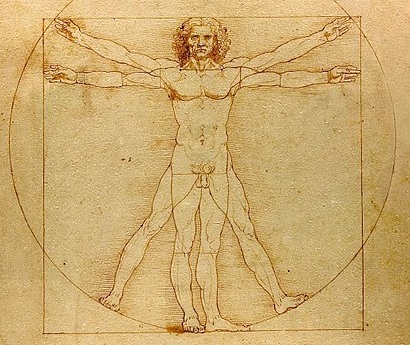Paradoxically, the most direct applications of da Vinci's researches outside art are to be found within his art. His understanding of physics, botany and geology vastly enhanced his painting. His study of light enabled him to develop sfumato, the technique that gives the outlines of his subjects their naturally undefined quality. “And if he hadn't studied anatomy, he wouldn't have been able to paint the most enigmatic smile in the history of painting,” says Fiorenzo Galli, the director-general of the Museo Nazionale Scienza e Tecnologia Leonardo da Vinci in Milan.
矛盾的是,達·芬奇在藝術之外的研究最直接的應用是在他的藝術中發現的。他對物理學、植物學和地質學的理解大大提高了他的繪畫水平。基于對光的研究他發展了渲染層次,這一技術賦予其畫作自然而又與眾不同的品質。“如果他沒學過解剖學,他就他不可能畫出繪畫史上最神秘的微笑,”米蘭達·芬奇科技博物館館長菲奧倫佐·加利表示。

The “Mona Lisa” has become the world's best-known painting. Da Vinci's “Vitruvian Man” is the world's best-known drawing. Does that make him the greatest artist in the Western tradition? Even Professor Kemp, who has spent a lifetime studying da Vinci's achievements, hesitates to go that far, stressing instead the Tuscan master's huge influence on other painters.“If you were looking for someone who did as much to divert the stream of art, then you would have to keep searching until you came to Picasso,” he says. Da Vinci revolutionised Madonna and Child compositions, and altered the portrayal of narrative subjects and the way portraits were composed. Jonathan Nelson, who teaches art history at Syracuse University in Florence, notes that he was also the first artist to give women realistic bodies “with anatomically identifiable musculatures, but looking soft and feminine”.
《蒙娜麗莎》已成為世界上最著名的畫作。達·芬奇作品《維特魯威人》是世界上最著名的素描。這是否使他成為西方歷史上最偉大的藝術家?即使是他花了一生的時間研究達·芬奇成就的坎普教授,也不愿說得太滿,反而強調這位托斯卡納大師對其他畫家的巨大影響。“如果你要找的是一個同樣能改變藝術潮流的人,那么你就得繼續尋找直到找到畢加索,”坎普教授如此表示。達·芬奇徹底改變了《圣母子》的構圖,改變了敘事題材的刻畫和肖像的構圖方式。在佛羅倫薩雪城大學教授藝術史的喬納森•納爾遜指出,他也是第一個賦予女性逼真身體的藝術家,“具有解剖學上可辨認的肌肉特征,但看上去柔軟而女性化”。
The notion that da Vinci stands alongside Michelangelo and Raphael at the very pinnacle of artistic achievement is nonetheless relatively modern. Until well into the 19th century, he was seen as a genius, but on a level below the others. As Donald Sassoon, a British historian, has recounted in his book, “Becoming Mona Lisa”, published in 2001, it was anti-clerical French historians who initiated the “cult of Leonardo”, seeing in him an ally in the fight against religious obscurantism: “He was not afraid to dissect corpses; he did not paint halos on his religious figures…Unlike Raphael and Michelangelo, he was never the servant of popes. He put Man at the centre of creation.”
盡管如此,“達·芬奇與米開朗基羅和拉斐爾一樣站在藝術成就之巔”這種觀點還是相對現代的。19世紀之前,他一直被認為是天才,但水平在米開朗基羅和拉斐爾之下。正如英國歷史學家唐納德•沙遜在2001年出版的《成為蒙娜麗莎》一書中所述,正是反宗教的法國歷史學家發起了“達·芬奇崇拜”,認為他是反對宗教蒙昧主義的盟友:“他不畏懼解剖尸體;他沒有為宗教人物畫光環……與拉斐爾和米開朗基羅不同,他從來不是教皇的仆人。他把人放在創造的中心。”
Those and other factors have endeared him to a wider, contemporary public. Da Vinci abhorred the slaughter of animals and was probably a vegetarian. He satisfies the modern requirement for artists to be outsiders with an eccentric streak. And his creative record chimes perfectly with the spirit of an age that tolerates, even venerates, unfinished work—all the more so if it is cryptic. Surveying the events this year to celebrate da Vinci's genius, Professor Nelson says “I think these shows tell us more about us than about him.”
上述等因素使達·芬奇受到更廣泛的當代公眾的喜愛。達·芬奇憎惡屠殺動物,他可能是一個素食主義者。他以一種古怪的氣質滿足了現代藝術家作為局外人的要求。他的創作記錄與這個時代的精神完美契合。這個時代容忍,甚至崇敬未完成的作品,如果作品是神秘的,那就更是如此。納爾遜教授在調查了今年為慶祝達·芬奇的天才而舉辦的活動后表示:“我認為這些展覽向我們展示的更多的是我們自己,而不是達·芬奇本人。”
譯文由可可原創,僅供學習交流使用,未經許可請勿轉載。












